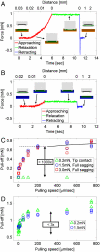Microstructured elastomeric surfaces with reversible adhesion and examples of their use in deterministic assembly by transfer printing
- PMID: 20858729
- PMCID: PMC2951455
- DOI: 10.1073/pnas.1005828107
Microstructured elastomeric surfaces with reversible adhesion and examples of their use in deterministic assembly by transfer printing
Abstract
Reversible control of adhesion is an important feature of many desired, existing, and potential systems, including climbing robots, medical tapes, and stamps for transfer printing. We present experimental and theoretical studies of pressure modulated adhesion between flat, stiff objects and elastomeric surfaces with sharp features of surface relief in optimized geometries. Here, the strength of nonspecific adhesion can be switched by more than three orders of magnitude, from strong to weak, in a reversible fashion. Implementing these concepts in advanced stamps for transfer printing enables versatile modes for deterministic assembly of solid materials in micro/nanostructured forms. Demonstrations in printed two- and three-dimensional collections of silicon platelets and membranes illustrate some capabilities. An unusual type of transistor that incorporates a printed gate electrode, an air gap dielectric, and an aligned array of single walled carbon nanotubes provides a device example.
Conflict of interest statement
The authors declare no conflict of interest.
Figures




References
-
- Geim AK, et al. Microfabricated adhesive mimicking gecko foot-hair. Nat Mater. 2003;2:461–463. - PubMed
-
- Murphy MP, Aksak B, Sitti M. Gecko-inspired directional and controllable adhesion. Small. 2009;5:170–175. - PubMed
-
- Kim S, Sitti M, Xie T, Xiao X. Reversible dry micro-fibrillar adhesives with thermally controllable adhesion. Soft Matter. 2009;5:3689–3693.
-
- Lees AD, Hardie J. The organs of adhesion in the aphid megoura viciae. J Exp Biol. 1988;136:209–228.
Publication types
MeSH terms
Substances
LinkOut - more resources
Full Text Sources
Other Literature Sources
Miscellaneous

